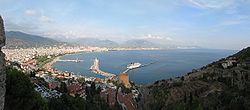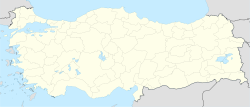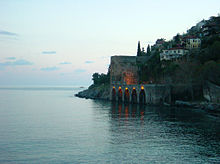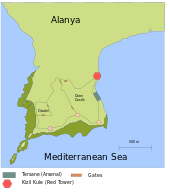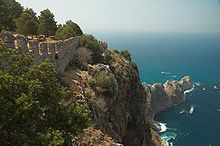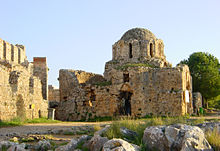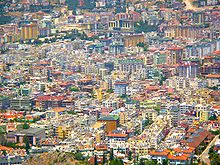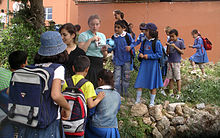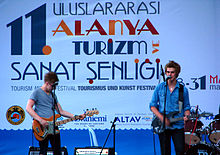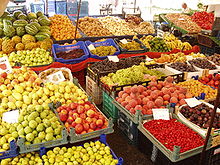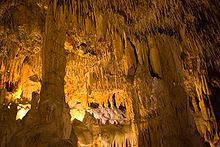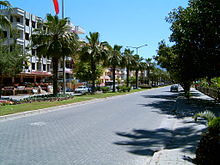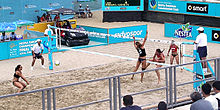- Alanya
-
Alanya — District — Alanya city center and harbor 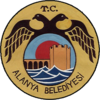
Seal
LogoNickname(s): Güneşin Gülümsediği Yer
("Where the Sun Smiles")Location of Alanya Coordinates: 36°33′N 32°00′E / 36.55°N 32°E Country  Turkey
TurkeyRegion Mediterranean Province Antalya Incorporated 1872 Government – Type Strong Mayor-Council – Mayor Hasan Sipahioğlu (AKP) – Governor Hulusi Doğan Area – District 610.8 sq mi (1,582 km2) Elevation 0–820 ft (0–250 m) Population (2010)[1][2][3] – District 248,286 – Density 393.7/sq mi (152/km2) – Urban 98,627 – Demonym Alanyalılar Time zone EET (UTC+2) – Summer (DST) EEST (UTC+3) Postal code 07400 Area code(s) (0090)+ 242 Licence plate 07 Website www.alanya.bel.tr
www.alanya.gov.trAlanya (pronounced [aˈɫanja]), formerly Alaiye, is a beach resort city and a component district of Antalya Province in the Mediterranean Region of Turkey, 166 kilometres (103 mi) from the city of Antalya. On the southern coast of Turkey, the district (which includes the city and its built-up area) has an area of 1,598.51 km2 and (2010 Census) 248,286 inhabitants (city 98,627).[1] The population is almost entirely of Turkish origin, but is home to around 10,000 European residents.
Because of its natural strategic position on a small peninsula into the Mediterranean Sea below the Taurus Mountains, Alanya has been a local stronghold for many Mediterranean-based empires, including the Ptolemaic, Seleucid, Roman, Byzantine, and Ottoman Empires. Alanya's greatest political importance came in the Middle Ages, with the Seljuk Sultanate of Rûm under the rule of Alaeddin Kayqubad I, from whom the city derives its name. His building campaign resulted in many of the city's landmarks, such as the Kızıl Kule (Red Tower), Tersane (Shipyard), and Alanya Castle.
The Mediterranean climate, natural attractions, and historic heritage makes Alanya a popular destination for tourism, and responsible for nine percent of Turkey's tourism sector and thirty percent of foreign purchases of real estate in Turkey. Tourism has risen since 1958 to become the dominant industry in the city, resulting in a corresponding increase in city population. Warm-weather sporting events and cultural festivals take place annually in Alanya. Mayor Hasan Sipahioğlu, of the Justice and Development Party, has led the city since 1999.
Contents
Names
The city has changed hands many times over the centuries, and its name has reflected this. Alanya was known in Latin as Coracesium or in Greek as Korakesion from the Luwian Korakassa meaning "point/protruding city".[4] Under the Byzantine Empire it become known as Kalonoros or Kalon Oros, meaning "beautiful/fine mountain" in Greek.[5] The Seljuks renamed the city Alaiye (علاعية), a derivative of the Sultan Alaeddin Kayqubad I's name. In the 13th and 14th centuries, Italian traders called the city Candelore or Cardelloro.[6] In his 1935 visit, Mustafa Kemal Atatürk finalized the name in the new alphabet as Alanya, changing the 'i' and 'e' in Alaiye, reportedly because of a misspelled telegram in 1933.[7][8]
History
For more details on medieval beylik period, see Alaiye.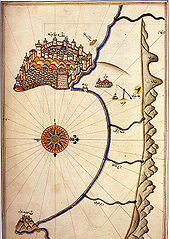 Piri Reis map of Alanya from 1525 showing the extent of the medieval city and the location on the Pamphylia plain.
Piri Reis map of Alanya from 1525 showing the extent of the medieval city and the location on the Pamphylia plain.
Finds in the nearby Kadrini cave indicate occupation during the Paleolithic era as far back as 20,000 BC,[9] and archeological evidence shows a port existed at Syedra, south of the modern city, during the Bronze Age around 3,000 BC.[10] A Phoenician language tablet found in the district dates to 625 BC, and the city is specifically mentioned in the 4th-century BC Greek geography manuscript, the periplus of Pseudo-Scylax.[9] The castle rock was likely inhabited under the Hittites and the Achaemenid Empire, and was first fortified in the Hellenistic period following the area's conquest by Alexander the Great.[11] Alexander's successors left the area to Ptolemy I Soter after 323 BC. His dynasty maintained loose control over the mainly Isaurian population, and the port became a popular refuge for Mediterranean pirates.[4] The city resisted Antiochus III the Great of the neighboring Seleucid kingdom in 199 BC, but was loyal to the pirate Diodotus Tryphon when he seized the Seleucid crown from 142 to 138 BC. His rival Antiochus VII Sidetes completed work in 137 BC on a new castle and port, begun under Diodotus.[12]
The Roman Republic fought Cilician pirates in 102 BC, when Marcus Antonius the Orator established a proconsulship in nearby Side, and in 78 BC under Servilius Vatia, who moved on the Isaurian tribes.[13] The period of piracy in Alanya finally ended after the city's incorporation into the Pamphylia province by Pompey in 67 BC, with the Battle of Korakesion fought in the city's harbor.[14] Isaurian banditry remained an issue under the Romans, and the tribes revolted in the fourth and fifth centuries AD, with the largest rebellion being from 404 to 408.[15] After the Roman Empire's collapse and split, the city remained under Byzantine influence, becoming a suffragan of Side, in the metropolis of Pamphylia Prima.[16] Islam arrived in the 7th century with Arab raids, which led to the construction of new fortifications.[9] 681 marked the end of a bishopric in Alanya, although St. Peter of Atroa may have taken refuge here from iconoclastic persecution in the early 9th century.[16][17] The area fell from Byzantine control after the Battle of Manzikert in 1071 to tribes of Seljuk Turks, only to be returned in 1120 by John II Komnenos.[18]
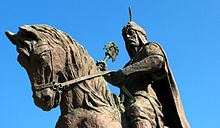 Statue of Kayqubad I in Alanya
Statue of Kayqubad I in Alanya
Following the Fourth Crusade's attack on the Byzantines, the Christian Armenian Kingdom of Cilicia periodically held the port, and it was from an Armenian, Kir Fard, that the Turks took lasting control in 1221 when the Anatolian Seljuk Sultan Alaeddin Kayqubad I captured it, assigning the former ruler, whose daughter he married, to the governance of the city of Akşehir.[19] Seljuk rule saw the golden age of the city, and it can be considered the winter capital of their empire.[20] Building projects, including the twin citadel, city walls, arsenal, and Kızıl Kule, made it an important seaport for western Mediterranean trade, particularly with Ayyubid Egypt and the Italian city-states.[21] Alaeddin Kayqubad I also constructed numerous gardens and pavilions outside the walls, and many of his works can still be found in the city. These were likely financed by his own treasury and by the local emirs, and constructed by the contractor Abu 'Ali al-Kattani al-Halabi.[11] Alaeddin Kayqubad I's son, Sultan Gıyaseddin Keyhüsrev II, continued the building campaign with a new cistern in 1240.[22]
At the Battle of Köse Dağ in 1242, the Mongol hordes broke the Seljuk hegemony in Anatolia. Alanya was then subject to a series of invasions from Anatolian beyliks. In 1293, the Karamanid dynasty took control after Mecdüddin Mahmud conquered the city, but their rule was intermittent.[23] Lusignans from Cyprus briefly overturned the then ruling Hamidid Dynasty in 1371.[24] The Karamanids sold the city in 1427 for 5,000 gold coins to the Mamluks of Egypt for a period before General Gedik Ahmed Pasha in 1471 incorporated it into the growing Ottoman Empire. The city was made a capital of a local sanjak in the eyalet of Içel.[5] The Ottomans extended their rule in 1477 when they brought the main shipping trade, lumber, then mostly done by Venetians, under the government monopoly.[21] On September 6, 1608, the city rebuffed a naval attack by the Order of Saint Stephen from the Republic of Venice.[6]
Trade in the region was negatively impacted by the development of an oceanic route from Europe around Africa to India, and in the tax registers of the late sixteenth century, Alanya failed to qualify as an urban center.[25] In 1571 the Ottomans designated the city as part of the newly conquered province of Cyprus.[9] The conquest further diminished the economic importance of Alanya's port. Traveler Evliya Çelebi visited the city in 1671/1672, and wrote on the preservation of Alanya Castle, but also on the dilapidation of Alanya's suburbs.[5] The city was reassigned in 1864 under Konya, and in 1868 under Antalya, as it is today.[9] During the 18th and 19th centuries numerous villas were built in the city by Ottoman nobility, and civil construction continued under the local dynastic Karamanid authorities.[4] Bandits again became common across Antalya Province in the mid-nineteenth century.[26]
After World War I, Alanya was nominally partitioned in the 1917 Agreement of St.-Jean-de-Maurienne to Italy, before returning to the Turkish Republic in 1923 under the Treaty of Lausanne.[27] Like others in this region, the city suffered heavily following the war and the population exchanges that heralded the Turkish Republic, when many of the city's Christians resettled in Nea Ionia, outside Athens. The Ottoman census of 1893 listed the number of Greeks in the city at 964 out of a total population of 37,914.[28] Tourism in the region started among Turks who came to Alanya in the 1960s for the alleged healing properties of Damlataş Cave, and later the access provided by Antalya Airport in 1998 allowed the town to grow into an international resort. Strong population growth through the 1990s was a result of immigration to the city, and has driven a rapid modernization of the infrastructure.[29]
Geography
Located on the Gulf of Antalya on the Anatolian coastal plain of Pamphylia, the town is situated between the Taurus Mountains to the north and the Mediterranean Sea, and is part of the Turkish riviera, occupying roughly 70 kilometres (43 mi) of coastline.[30] From west to east, the Alanya district is bordered by the Manavgat district along the coast, the mountainous Gündoğmuş inland, Hadim and Taşkent in the Province of Konya, Sarıveliler in the Province of Karaman, and the coastal Gazipaşa district.[31] Manavgat is home to the ancient cities of Side and Selge.
The Pamphylia plain between the sea and the mountains is an isolated example of an Eastern Mediterranean conifer-sclerophyllous-broadleaf forest, which include Lebanon Cedar, evergreen scrub, fig trees, and black pine.[32] The Alanya Massif refers to the area of metamorphic rocks east of Antalya. This formation is divided into three nappes from lowest to highest, the Mahmutlar, the Sugözü, and the Yumrudağ. The similar lithology extends beneath the city in a tectonic window.[33] Bauxite, an aluminum ore, is common to the area north of city, and can be mined.[34]
The town is divided east–west by a rocky peninsula, which is the distinctive feature of the city. The harbor, city center, and Keykubat Beach, named after the Sultan Kayqubad I, are on the east side of the peninsula. Damlataş Beach, named for the famous "dripping caves", and Cleopatra Beach are to the west. The name Cleopatra Beach possibly derives from either the Ptolemaic princess' visit here or the area's inclusion in her dowry from Mark Antony.[35][36] Atatürk Bulvarı, the main boulevard, runs parallel to the sea, and divides the southern, much more touristic side of Alanya from the northern, more indigenous side that extends north into the mountains. Çevre Yolu Caddesi, another major road, encircles the main town to the north.
Climate
Alanya has a typical Mediterranean climate. The Mediterranean Basin ensures that most rain comes during the winter, leaving the summers long, hot, and dry,[37] prompting the Alanya board of Tourism to use the slogan "where the sun smiles".[38] Storm cells sometimes bring with them fair weather waterspouts when close to the shore.[39] The presence of the Taurus Mountain in close proximity to the sea causes fog, in turn creating visible rainbows many mornings. The height of the mountains creates an interesting effect as snow can often be seen on them even on hot days in the city below. The sea at Alanya has an average temperature of 21.4 °C (71 °F) annually, with an average August temperature of 27.9 °C (82 °F).[40]
Climate data for Alanya Month Jan Feb Mar Apr May Jun Jul Aug Sep Oct Nov Dec Year Average high °C (°F) 16.2
(61.2)16.3
(61.3)18.3
(64.9)21.1
(70.0)24.7
(76.5)28.7
(83.7)31.5
(88.7)32.0
(89.6)30.2
(86.4)26.5
(79.7)21.6
(70.9)17.7
(63.9)23.73
(74.72)Daily mean °C (°F) 11.8
(53.2)11.9
(53.4)13.8
(56.8)16.9
(62.4)20.9
(69.6)25.0
(77.0)27.7
(81.9)27.9
(82.2)25.4
(77.7)21.3
(70.3)16.5
(61.7)13.2
(55.8)19.36
(66.84)Average low °C (°F) 8.6
(47.5)8.4
(47.1)10.1
(50.2)13.0
(55.4)16.7
(62.1)20.4
(68.7)23.3
(73.9)23.6
(74.5)21.2
(70.2)17.4
(63.3)13.0
(55.4)10.0
(50.0)15.48
(59.86)Precipitation mm (inches) 199.6
(7.858)148.7
(5.854)98.6
(3.882)65.5
(2.579)33.7
(1.327)9.9
(0.39)10.0
(0.394)5.7
(0.224)19.1
(0.752)98.6
(3.882)187.6
(7.386)231.5
(9.114)1,108.5
(43.642)% humidity 57 57 61 63 66 66 64 65 58 55 59 60 60.9 Avg. rainy days 13.8 11.6 9.6 8.5 4.8 1.8 1.3 1.6 2.9 6.8 10.0 13.1 85.8 Sunshine hours 130.2 131.6 198.4 231.0 300.7 330.0 337.9 322.4 279.0 223.2 168.0 136.4 2,788.8 Source no. 1: Turkish State Meteorological Service [41] Source no. 2: Weather2 [42] Architecture
On the peninsula stands Alanya Castle, a Seljuk era citadel dating from 1226. Most major landmarks in the city are found inside and around the castle. The current castle was built over existing fortifications and served the double purpose of a palace of local government and as a defensive structure in case of attack. In 2007, the city began renovating various sections of the castle area, including adapting a Byzantine church for use as a Christian community center.[43] Inside the castle is the Süleymaniye mosque and caravanserai, built by Suleiman the Magnificent.[44] The old city walls surround much of the eastern peninsula, and can be walked. Inside the walls are numerous historic villas, well preserved examples of the classical period of Ottoman architecture, most built in the early 19th century.
The Kızıl Kule (Red Tower) is another well-known building in Alanya. The 108-foot (33 m) high brick building stands at the harbor below the castle, and contains the municipal ethnographic museum. Sultan Kayqubad I brought the accomplished architect Ebu Ali from Aleppo, Syria to Alanya to design the building.[45] The last of Alanya Castle's 83 towers, the octagonal structure specifically protected the Tersane (dockyard), it remains one of the finest examples of medieval military architecture.[46] The Tersane, a medieval drydock built by the Seljuk Turks in 1221, 187 by 131 feet (57 by 40 m), is divided into five vaulted bays with equilateral pointed arches.[44] The Alarahan caravanserai near Manavgat, also built under Kayqubad's authority, has been converted into a museum and heritage center.[47]
Atatürk's House and Museum, from his short stay in the city on February 18, 1935 is preserved in its historic state and is a good example of the interior of a traditional Ottoman villa, with artifacts from the 1930s. The house was built between 1880 and 1885 in the "karniyarik" (stuffed eggplant) style. Bright colors and red roofs are often mandated by neighborhood councils, and give the modern town a pastel glow. Housed in a 1967 Republican era building, The Alanya Museum is inland from Damlataşh Beach.[48] With its rich architectural heritage, Alanya is a member of the Norwich-based European Association of Historic Towns and Regions.[49] In 2009, city officials filed to include Alanya Castle and Tersane as UNESCO World Heritage Sites, and were named to the 2009 Tentative List.[50][51]
Demographics
Further information: Demographics of TurkeyHistorical Populations Alanya District Year Population +/- 1985 87080 - 1990 129936 49% 1997 222028 71% 2000 264240 19% 2007 384949 46% Alanya City Center 1893 37914 - 1985 28733 -24% 1990 52460 83% 1997 110181 110% 2000 88346 -20% 2007 91713 4% 2008 92223 1% 2009 94316 2% Turkish/Ottoman census[2][28]
Address based registration[52]From only 87,080 in 1985, the district has surged to hold a population of 384,949 in 2007.[2][3] This population surge is largely credited to immigration to the city as a result or byproduct of the increased prominence of the real estate sector and the growth of the housing market bubble.[53] The city itself has a population of 134,396, of which 9,789 are European expatriates, about half of them from Germany and Denmark.[54] 17,850 total foreigners own property in Alanya.[55] The European expatriate population tends to be over fifty years old.[56] During the summer the population increases due to large numbers of tourists, about 1.1 million each year pass through the city.[30] Both Turks and Europeans, these vacationers provide income for much of the population.
The city is home to many migrants from the Southeastern Anatolia Region and the Black Sea region. In the first decade of the 21st century, the town has seen a surge in illegal foreign immigrants from the Middle East and South Asia, both to stay and to attempt to enter European Union countries.[57] As of 2006, 1,217 migrants claim residence in Alanya while working abroad.[58] Yörük nomads also live in the Taurus Mountains north of the city on a seasonal basis.[59] Additionally, there is a small African community descendant from imported Ottoman slaves.[60]
The town is nearly 99% Muslim, and although many ancient churches can be found in the city, there are no regular Christian services. In 2006, a German language Protestant church with seasonal service opened with much fanfare, after receiving permission to do so in 2003, a sign of the growing European population in the city.[61] The town provides the Atatürk Cultural Center to Christian groups on a regular basis for larger religious ceremonies.[62]
Education and health
Further information: Education in TurkeyThe city has 95% literacy, with public and private schools, and a roughly 1:24 student-teacher ratio.[30] Rural villages are, however, disadvantaged by the limited number of secondary schools outside the city center. Alantur Primary School, which opened in 1987, was built and is maintained under the Turkish "Build Your Own School" initiative, supported by the foundation of Ayhan Şahenk, the founder of Doğuş Holding.[63]
In 2005, Akdeniz University of Antalya launched the Alanya Faculty of Business, as a satellite campus that focuses on the tourism industry.[64] The school hosts an International Tourism Conference annually in coordination with Buckinghamshire New University.[65] The city also has plans to open a private university in 2012.[66] Georgetown University operates an annual study abroad program for American students known as the McGhee Center for Eastern Mediterranean Studies, named for the United States Ambassador to Turkey from 1952–53 George C. McGhee, and based in his villa.[67] Başkent University Medical and Research Center of Alanya, a teaching hospital run by Başkent University in Ankara is one of nineteen hospitals in Alanya.[68] Other major hospitals include the 300-bed Alanya State Hospital and the 90-bed Private Hayat Hospital.[69]
Culture
 The Kızıl Kule, or Red Tower, is also home to the city ethnographic museum.
The Kızıl Kule, or Red Tower, is also home to the city ethnographic museum.
Alanya's culture is a subculture of the larger Culture of Turkey. The city's seaside position is central to many annual festivals. These include the Tourism and Art Festival, which marks the opening of the tourism season from at the end of May or beginning of June.[70][71] At the opposite end of the season, the Alanya International Culture and Art Festival is held in the last week of May, and is a notable Turkish festival.[72] Other regular festivals include the Alanya Jazz Days, which has been held since 2002 in September or October at the Kızıl Kule, which is otherwise home to the municipal ethnographic museum. The Jazz Festival hosts Turkish and international jazz musicians in a series of five free concerts.[73]
The Alanya Chamber Orchestra, formed of members of the Antalya State Opera and Ballet, gave its inaugural performance on December 7, 2007.[74] The International Alanya Stone Sculpture Symposium, begun is 2004, is held over the month of November.[75] The Alanya Documentary Festival was launched in 2001 by the Alanya Cinémathèque Society and the Association of Documentary Filmmakers in Turkey.[76] Onat Kutlar, Turkish poet and writer, and founder of the Istanbul International Film Festival was born in Alanya, as was actress Sema Önür.[77]
Atatürk's visit to Alanya is also celebrated on its anniversary each February 18, centered on Atatürk's House and Museum.[4] The Alanya Museum is home to archaeology found in and around the city, including a large bronze Hercules statue, ceramics, and Roman limestone ossuaries, as well as historic copies of the Qur'an.[48][78] European residents of Alanya also often celebrate their national holidays, such as Norwegian Constitution Day,[79] and the city set up a Christmas market in December 2010.[80] Iranians also celebrate the Persian New Year, Nevruz, in Alanya.[81]
Government
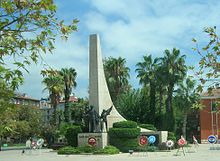 Many national celebrations are centered at the downtown Mustafa Kemal Atatürk monument.
Many national celebrations are centered at the downtown Mustafa Kemal Atatürk monument.
Alanya was set up as a municipality in 1872, electing its first mayor in 1901. Today, Alanya is governed by a mayor and a municipality council made up of twenty-five members. Twelve councilors are of the Justice and Development Party (AK Party), which is currently in power in the national government. Eight councilors are from the center-right Motherland Party, with three members from the center-left Republican People's Party, two from the far-right Nationalist Movement Party.[82] Mayor Hasan Sipahioğlu was formerly with the Motherland Party, but on July 12, 2009 joined the AK Party.[83] Sipahioğlu was first elected in 1999, and was reelected in 2004 and 2009. Elections are held every five years, with the next to be held in March 2014. Alanya also has a deputy mayor, who often represents the city at its sporting events.[84]
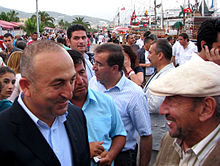 MP Mevlüt Çavuşoğlu (on the left) is also President of the Parliamentary Assembly of the Council of Europe.
MP Mevlüt Çavuşoğlu (on the left) is also President of the Parliamentary Assembly of the Council of Europe.
Alanya District is divided up into 17 municipalities, including the city center, and 92 villages.[2] Alanya is greatly influenced by the provincial government in Antalya, and the national government in Ankara, which appoints a governor for the district, currently Dr. Hulusi Doğan.[85] Although Alanya has been part of Antalya Province since the Ottoman Empire, many local politicians have advocated a separate Alanya Province, a position supported by associations of foreign residents.[86]
Nationally, in the 2007 election, the province voted with the Justice and Development Party, who were followed closely by the Republican People's Party and the True Path Party.[87] Mevlüt Çavuşoğlu, of the Justice and Development Party, is the only native Alanyalilar Member of Parliament representing Antalya Province in the Grand National Assembly, where he chairs the Committee on Migration, Refugees and Population.[88] He is also the current president of the Parliamentary Assembly of the Council of Europe.
Economy
The tourist industry in Alanya is worth just under 1.1 billion euros per year, and is therefore the principal industry.[30] The area is further known for its many fruit farms, particularly lemons and oranges, and large harvests of tomatoes, bananas and cucumbers.[30][89] About 80,000 tonnes of citrus fruits were produced in 2006 across 16,840 hectares (41,600 acres). The greengage plum and the avocado are increasingly popular early season fruits where citrus fruits are becoming unprofitable.[90]
Despite the seaside location, few residents make their living on the sea, and fishing is not a major industry. In the early 1970s, when fish stocks ran low, a system of rotating access was developed to preserve this sector.[91] This innovative system was part of Elinor Ostrom's research on economic governance which led to her 2009 Nobel Prize in Economics.[92] In 2007, locals protested the establishment of some larger chain supermarkets and clothing stores, which have opened branches in Alanya.[93]
Beginning in 2003, with the provisional elimination of restrictions on land purchases by non-nationals, the housing industry in the city has become highly profitable with many new private homes and condominiums being built for European and Asian part-time residents.[53] Sixty-nine percent of homes purchased by foreign nationals in the Antalya Province and 29.9% in all of Turkey are in Alanya.[55][94] Buyers are primarily individuals, rather than investors.[95] This housing boom put pressure on the city's many gecekondu houses and establishments as property values rise and property sales to locals fall.[96] A height restriction in the city limits most buildings to 21 feet (6.5 m).[97] This keeps high rise hotels to the east and west of the city, preserving the central skyline at the expense of greater tourist potential. The fringes of the city however have seen uncontrolled expansion.[98]
Tourism
Since the first modern motel was built in 1958, considered the first year of the tourist industry in Alanya, hotels have raced to accommodate the influx of tourists, and the city as of 2007 claims 157,000 hotel beds.[29][99] Damlataş Cave, which originally sparked the arrival of outsiders because of the cave's microclimate, with an average temperature of 72 °F (22 °C) and 95% humidity, is accessible on the west side of the peninsula with trails from Damlataş Beach.[100] Many tourists, especially Scandinavians, Germans, Russians, and Dutch, regularly vacation in Alanya during the warmer months.[101] They are drawn to the area because of property prices, warm weather, sandy beaches, access to Antalya's historic sites, and fine cuisine.[102]
Other outdoor tourist activities include wind surfing, parasailing, and banana boating. Attractions include Europe's largest waterpark, Sealanya, and Turkey's largest go-kart track.[103] Hunting season also attracts some tourist for wild goat, pig and partridge hunting in area nature reserves.[104]
For various reasons, tourist seasons after 2005 have been disappointing for Alanya's tourism industry. Among the reasons blamed were increased PKK violence, the H5N1 bird flu found in Van, and the Mohammad cartoon controversy.[105] Alanya officials have responded with a variety of publicity initiatives, including baking the world's longest cake on April 26, 2006, a Guinness World Record.[106] The economy has also suffered due to investment in more than 20,000 surplus properties.[93]
Media
Alanya has 10 local daily newspapers.[30] One of these is Yeni Alanya, which includes the news and lifestyles magazine Orange and is available in English, German and Turkish. Two native German language newspapers are published in Alanya, the Aktuelle Türkei Rundschau and Alanya Bote for the community of German speaking residents and visitors. A monthly magazine Hello Alanya published in Alanya for foreigners, appearing in English and Dutch.[107] The free regional newspaper, Riviera News, is printed in English and is widely available in Alanya.
Five radio stations broadcast from the city.[30] Alanya FM Radyo broadcasts on 106.0 FM and is partnered with Radio Flash, on 94.0 FM, both broadcasting popular music.[108] Other stations include Alanya RadyoTime on 92.3 FM, which broadcasts a variety of Turkish music, news, and talk programming.[109] Two television stations are local to Alanya, Kanal Alanya, and Alanya Televizyonu, abbreviated ATV, which is partnered with Alanya RadyoTime.[110][111]
Transportation
Further information: Transport in TurkeyThe D 400 Highway, the Alanya–Mersin Route, connects Alanya from the east and west, encircling it, and linking through the city center via Atatürk Bulvarı. The D695, the Ankara–Akşehir Route, runs north–south and reaches the sea 41 kilometres (25 mi) west of the city near Side, connecting with the D400. Antalya Airport is 121 kilometres (75 mi) away and connects internationally. The new Antalya Gazipaşa Airport, first begun in 1992, is only 14.5 kilometres (9.0 mi) from the city, and was expected to have its first regular domestic flights on May 22, 2010, although international flights were not expected before the start of the 2011 tourist season.[112] No train routes go to Alanya or Antalya Province, and there are no train stations in the district.[113]
There are bus and dolmuş systems out of Alanya's two bus depots, but buses are usually limited to the major roads, and inside the city transportation is by car, taxi, or foot, as many roads in the old town are closed to vehicle traffic. The harbor includes cruise ship piers, and also seasonal ferries and hydrofoils depart for Kyrenia in the Turkish Republic of Northern Cyprus.[114] Further west of the city is the Alanya Yacht Harbor, a marina, which started services in 2008.[115] The 85-km2 (33-sq-mi) marina allowed Alanya to participate in the 2008 Eastern Mediterranean Yacht Rally.[116][117] The city is also investing in a community bicycle program with 150 bicycles and twenty terminals.[118]
Sports
Alanya is home to a woman's basketball team, Alanya Belediye, which started in the first division but was relegated after the 2002 season. The city hosts a third level soccer team, Alanyaspor. The club was founded in 1948, and play home games at Milli Egemenlik Stadium. It played in the Second League between 1988-1997. In 2007, the city began constructing a new soccer facility with the intention of hosting winter competitions between major teams.[119] The public Alanya Municipality Sports Facility is located adjacent to Milli Egemenlik Stadium, which is one of thirteen facilities.[120][121]
Alanya's waterfront location makes it suitable for certain events, and is perhaps most famous for its annual triathlon, part of the International Triathlon Union series, which has been held every October since 1990.[122] Marathon swimming competitions have also been connected to the triathlon since 1992.[123] Building on the triathlon's success, Alanya hosted a modern pentathlon in 2009.[124] Alanya is also the regular host of The Turkish Open, part of the Nestea European Beach Volleyball championship tour, which takes place in May.[125] In 2007, the Turkish Volleyball Federation persuaded the European Volleyball Confederation to build a beach volleyball training facility in Alanya, and make it the exclusive "center of beach volleyball in Europe".[126]
The city is also a frequent host to national events, such as the annual beach handball tournament, and the finish of the seven-day Presidential Cycling Tour of Turkey.[84][127] Other cycling events include the Alanya International Mountain Bike Race.[128] Additionally, the European Cycling Union had its 2010 European road cycling championship and 2010 ordinary congress meeting in Alanya.[129]
Sister cities
Since making agreements with Talsi, Trakai, and Keszthely in 2006, Borås in 2007, and Rovaniemi, Špindlerův Mlýn, and Moscow in 2009, Alanya increased its number of sister cities to twelve, ten of which are located within the European Union.[130][131][132] In 2005 Alanya applied with Sister Cities International for an additional sister city from the United States.[133] The most significant tie is with the city of Nea Ionia, where many of Alanya's Christians were resettled in 1923 after the Treaty of Lausanne. Soccer teams from sister cities Wodzisław Śląski and Schwechat have also come to train and scrimmage in Alanya.[134][135] Wodzisław, Schwechat, Gladbeck, Fushun, and Alanya form a "family" in that most are partnered with the others. During the annual Tourism and Culture Festival, Alanya dedicates the year to focus on one country, and has involved sister cities, such as Trakai when 2009 was declared the "Year of Lithuania."[136]
See also
References
- ^ a b "Statistical Institute page for Antalya". Address Based Population Registration System (ABPRS) Database. Turkish Statistical Institute. 2011. http://report.tuik.gov.tr/reports/rwservlet?adnksdb2=&ENVID=adnksdb2Env&report=idari_yapi_09sonrasi.RDF&p_il1=7&p_yil=2010&p_dil=2&desformat=html. Retrieved August 24, 2011.
- ^ a b c d "Nüfusu ve Demografik Boyutları". Alanya municipality. 2002. http://www.alanya.bel.tr/alanya/nufus.asp. Retrieved September 7, 2008.
- ^ a b "Alanya in Numbers". Alanya municipality. 2007. http://www.alanya.bel.tr/translationEN/rakalanya.asp. Retrieved September 7, 2008.
- ^ a b c d "Alanya – Korekesion". Daily Life, Culture, and Ethnography of Antalya. Antalya Valiliği. February 6, 2008. Archived from the original on August 26, 2007. http://web.archive.org/web/20070824152756/http://www.discoverturkey.com/english/iller/e-antalya.html. Retrieved September 7, 2008.
- ^ a b c Crane, Howard (1993). "Evliya Çelebi's Journey through the Pamphylian Plain in 1671-72". Muqarnas 10 (Essays in Honor of Oleg Grabar): 157–168. doi:10.2307/1523182. JSTOR 1523182.
- ^ a b Mason, Roger (1989). "The Medici-Lazara Map of Alanya". Anatolian Studies 39: 85–105. doi:10.2307/3642815. JSTOR 3642815.
- ^ Yetkin, Haşim (1990). Dünden Bugüne Alanya. Antalya: Yetkin Dağitim. http://sunsearch.info/turkey/alanya/sights-information/when-ataturk-visited-alanya/. Retrieved March 10, 2008.
- ^ "Alaiye's Becoming Alanya". Alanyanın Web Sitesi. 2008. http://www.alanya.tv/en/AlanyaHistory/Alaiyes_Becoming_Alanya/. Retrieved August 1, 2008.
- ^ a b c d e "The History of Alanya". Ministry of Tourism. http://www.kultur.gov.tr/EN/Genel/BelgeGoster.aspx?17A16AE30572D313679A66406202CCB03183B17125FC74AB. Retrieved September 7, 2008.
- ^ "Relics of a 5,000-year-old port found in southern Turkey". World Bulletin. August 24, 2011. http://www.worldbulletin.net/?aType=haber&ArticleID=77965. Retrieved August 29, 2011.
- ^ a b Rogers, J. M (1976). "Waqf and Patronage in Seljuk Anatolia: The Epigraphic Evidence". Anatolian Studies 26: 82, 83, 85, 97–98. doi:10.2307/3642717. JSTOR 3642717.
- ^ Acar, Özgen (October 10, 2005). "Alanya's graffiti from the Middle Ages being saved". Turkish Daily News. http://arama.hurriyet.com.tr/arsivnews.aspx?id=-561699. Retrieved May 2, 2009.
- ^ Sherwin-White, A. N. (1976). "Rome, Pamphylia and Cilicia, 133-70 B.C". The Journal of Roman Studies 66: 1–14. doi:10.2307/299775. JSTOR 299775.
- ^ de Souza, Philip (1997). "Romans and Pirates in a Late Hellenistic Oracle from Pamphylia". The Classical Quarterly 47 (2): 477–481. doi:10.1093/cq/47.2.477. JSTOR 639682.
- ^ Lenski, Noel (1999). "Assimilation and Revolt in the Territory of Isauria, from the 1st Century BC to the 6th Century AD". Journal of the Economic and Social History of the Orient 42 (4): 440–441. doi:10.1163/1568520991201687. JSTOR 3632602.
- ^ a b
 "Coracesium". Catholic Encyclopedia. New York: Robert Appleton Company. 1913.
"Coracesium". Catholic Encyclopedia. New York: Robert Appleton Company. 1913. - ^ "Patron Saints Index: Saint Peter of Atroa". Catholic Community Forum. April 29, 2007. http://www.catholic-forum.com/saints/saintp1j.htm. Retrieved February 17, 2008.
- ^ Vryonis, Jr, Speros (1975). "Nomadization and Islamization in Asia Minor". Dumbarton Oaks Papers 29: 41–71. doi:10.2307/1291369. JSTOR 1291369.
- ^ Redford, Scott (1993). "The Seljuqs of Rum and the Antique". Muqarnas 10: 149–151. doi:10.2307/1523181. JSTOR 1523181.
- ^ Yavuz, Ayşil Tükel (1997). "The Concepts That Shape Anatolian Seljuq Caravanserais". Muqarnas 14: 80–95. doi:10.2307/1523237. JSTOR 1523237.
- ^ a b Inalcik, Halil (1960). "Bursa and the Commerce of the Levant". Journal of the Economic and Social History of the Orient 3 (2): 143–147. doi:10.2307/3596293. JSTOR 3596293.
- ^ Arik, M. Oluş; Russell, James; Minzoni-Déroche, Angela; Erim, Kenan; Korfmann, Manfred; Cauvin, J; Aurenche, O; Erzen, Afıf et al. (1986). "Recent Archaeological Research in Turkey". Anatolian Studies 36: 173–174. doi:10.2307/3642834. JSTOR 3642834.
- ^ "Alâiye Beyligi". Selçuklu Tarihi. February 17, 2001. http://enfal.de/starih29.htm. Retrieved September 7, 2008.
- ^ "Hamid Dynasty". Encyclopædia Britannica. Encyclopædia Britannica Online. 2007. http://search.eb.com/eb/article-9039020. Retrieved January 29, 2007.
- ^ Erder, Leila T.; Suraiya Faroqhi (October 1980). "The Development of the Anatolian Urban Network during the Sixteenth Century". Journal of the Economic and Social History of the Orient 23 (3): 265–303. doi:10.2307/3632058. JSTOR 3632058.
- ^ "History of Kalkan". Five Star Hotels Antalya. 2006. http://www.fivestarhotelsantalya.com/antalya.asp?id=7&baslik=Kalkan. Retrieved February 24, 2008.
- ^ Helmreich, Paul C. (1976). "Italy and the Anglo-French Repudiation of the 1917 St. Jean de Maurienne Agreement". The Journal of Modern History 48 (2): 99. doi:10.1086/241525. JSTOR 1877819.
- ^ a b Karpat, Kemal H. (1978). "Ottoman Population Records and the Census of 1881/82-1893". International Journal of Middle East Studies 9 (3): 237–274. JSTOR 162764.
- ^ a b Hakları, Telif (2002). "Belediye Tarihi". http://www.alanya.bel.tr/belediye/tarihi.asp. Retrieved September 7, 2008.
- ^ a b c d e f g "Rakamlarla Alanya". Alanya Chamber of Commerce. 2005. http://www.altso.org.tr/index.php?option=com_content&task=view&id=18&Itemid=29&lang=en. Retrieved September 7, 2008.
- ^ Akiş, Ayhan (2007). "Alanya'da Turizm ve Turizmin Alanya Ekonimisine Etkisi". Selcuk Universitesi Sosyal Bilimler Enstitusu Dergisi (17): 15–32. ISSN 13021796. http://www.doaj.org/doaj?func=abstract&id=239534&q1=Is&f1=all&b1=and&q2=&f2=&recNo=9971. Retrieved February 23, 2008.
- ^ World Wildlife Fund (2001). "Terrestrial Ecoregions". National Geographic. http://www.nationalgeographic.com/wildworld/profiles/terrestrial/pa/pa1207.html. Retrieved September 7, 2008.
- ^ Koçkar, M. K.; H. Akgün (March 2003). "Engineering geological investigations along the Ilıksu Tunnels, Alanya, southern Turkey". Engineering Geology 68 (3–4): 141–158. doi:10.1016/S0013-7952(02)00204-1. http://linkinghub.elsevier.com/retrieve/pii/S0013795202002041. Retrieved February 22, 2008.
- ^ Temur, Sedat; Gürsel Kansun (September 1, 2006). "Geology and petrography of the Masatdagi diasporic bauxites, Alanya, Antalya, Turkey". Journal of Asian Earth Sciences 27 (4): 512–522. doi:10.1016/j.jseaes.2005.07.001. http://www.sciencedirect.com/science?_ob=ArticleURL&_udi=B6VHG-4J617XB-6&_user=10&_rdoc=1&_fmt=&_orig=search&_sort=d&view=c&_version=1&_urlVersion=0&_userid=10&md5=c0463f0fd860736b9f4b53cbb7649b68. Retrieved February 22, 2008.
- ^ "Kleopatra Beach". http://www.alanya.cc. 2007. http://www.alanya.cc/en/Beaches/92-Kleopatra-Beach.html. Retrieved September 7, 2008.
- ^ "Alanya / Alanya, Turkey". SunSearch Consulting Ltd. 2007. http://sunsearch.info/turkey/alanya/sights-information/alanya-city/. Retrieved September 7, 2008.
- ^ "Historical Weather for Alanya, Antalya, Turkey". Weatherbase. August 2010. http://www.weatherbase.com/weather/weather.php3?s=173202&refer=&cityname=Alanya-Turkey. Retrieved July 7, 2011.
- ^ "Summer sun for southern beaches, eastern Anatolia remains icy". Today's Zaman. February 9, 2008. http://www.todayszaman.com/tz-web/detaylar.do?load=detay&link=133604. Retrieved February 10, 2008.
- ^ "Waterspouts in Alanya". Istanbul Journal of Weather. Weather Underground. October 19, 2006. http://www.wunderground.com/blog/weatherist/comment.html?entrynum=3&tstamp=200610. Retrieved February 22, 2008.
- ^ "Turkey Statistical Yearbook" (PDF). State Institute of Statistics. 2004. http://www.die.gov.tr/yillik/yillik_2004.pdf. Retrieved September 7, 2008.
- ^ http://www.dmi.gov.tr/veridegerlendirme/il-ve-ilceler-istatistik.aspx?m=ALANYA
- ^ http://www.myweather2.com/City-Town/Turkey/Alanya/climate-profile.aspx?month=7
- ^ "Ancient Church needs support". Orange Alanya. April 15, 2007. http://english.arsiv.yenialanya.com/index.aspx?KatAd=Alanya%20News&KatId=33&Haberim=13338. Retrieved May 2, 2009.
- ^ a b "Historical Places". Alanya'nın Resmi Web Sitesi. 2007. http://www.alanya.bel.tr/translationEN/alanya/tarihiyerler.asp#2. Retrieved September 7, 2008.
- ^ "Kızıl Kule (Red Tower)". Alanya Cities and Historical Sites. Turkish Class. 2007. http://www.antalya-ws.com/english/location/alanya/history.asp?out=1. Retrieved September 7, 2008.
- ^ Dörner, F. K.; L. Robert; Rodney Young; Paul A. Underwood; Halet Çambel; Tahsin Özgüç; A. M. Mansel; A. Gabriel (1954). "Summary of Archaeological Work in Turkey in 1953". Anatolian Studies 4: 13–20. doi:10.2307/3642371. JSTOR 3642371.
- ^ Kutay, Kürşat (June 23, 2009). "Alarahan caravanserai now a major attraction". Hürriyet. http://www.hurriyet.com.tr/english/domestic/11929406.asp?scr=1. Retrieved June 28, 2009.
- ^ a b Anatolia News Agency (August 29, 2007). "Museums shed light on Anatolian history". Turkish Daily News. http://arama.hurriyet.com.tr/arsivnews.aspx?id=-613178. Retrieved May 2, 2009.
- ^ "Turkey" (DOC). Association of Historic Towns of Turkey. European Association of Historic Towns and Regions. http://www.historic-towns.org/documents/members/turkey.doc. Retrieved September 7, 2008.
- ^ "Alanya in line for ’World Heritage’ tag". Hürriyet. February 4, 2009. http://www.hurriyet.com.tr/english/domestic/10928808.asp?scr=1. Retrieved February 5, 2009.
- ^ "5 more sites from Turkey on UNESCO’s World Heritage Tentative List". Today's Zaman. April 24, 2009. http://www.todayszaman.com/tz-web/detaylar.do?load=detay&link=173323&bolum=110. Retrieved April 24, 2009.
- ^ "İlçelere göre merkez ve belde/köy nüfus toplamları". Turkish Statistical Institute. 2007. http://report.tuik.gov.tr/reports/rwservlet?adnksdb2=&report=turkiye_ilce_koy_sehir.RDF&p_il1=7&p_ilce1=82&p_kod=2&p_yil=2007&desformat=html&ENVID=adnksdb2Env. Retrieved July 7, 2009."İlçelere göre merkez ve belde/köy nüfus toplamları". Turkish Statistical Institute. 2008. http://report.tuik.gov.tr/reports/rwservlet?adnksdb2=&report=turkiye_ilce_koy_sehir.RDF&p_il1=7&p_ilce1=1126&p_kod=2&p_yil=2008&desformat=html&ENVID=adnksdb2Env. Retrieved July 7, 2009.
- ^ a b Çevik, Reeta (July 26, 2007). "New Alanya residents reshaping the area". Turkish Daily News. http://arama.hurriyet.com.tr/arsivnews.aspx?id=-610896. Retrieved May 2, 2009.
- ^ "Foreign interest in Alanya on the rise". Today's Zaman. May 1, 2007. Archived from the original on May 24, 2008. http://web.archive.org/web/20080524054352/http://www.todayszaman.com/tz-web/detaylar.do?load=detay&link=109871&bolum=132. Retrieved September 7, 2008.
- ^ a b Yilmaz, Fatih; Ahmet Yeşhil Fethiye (May 1, 2008). "Property prices fall with cancellation of law on property sales to foreigners". Today's Zaman. Archived from the original on May 2, 2008. http://web.archive.org/web/20080502044527/http://www.todayszaman.com/tz-web/detaylar.do?load=detay&link=140578. Retrieved May 3, 2008.
- ^ Yeşil, Ahmet (February 10, 2007). "Number of foreigners owning property in Turkey rapidly increasing". Today's Zaman. http://www.todayszaman.com/tz-web/detaylar.do?load=detay&link=102459&bolum=132. Retrieved September 7, 2008.[dead link]
- ^ Stevens, Kristen (December 19, 2006). "Migration matters in globalized Turkey". Turkish Daily News. http://arama.hurriyet.com.tr/arsivnews.aspx?id=-596027. Retrieved May 2, 2009.
- ^ Coşkun, Yadigar (2006). "Analyzing the Aspects of International Migration in Turkey" (PDF). Migration Research Program at the Koç University. http://home.ku.edu.tr/~mirekoc/reports/2005_2006_yadigar_coskun.pdf. Retrieved September 7, 2008.
- ^ "Yürüks struggle to keep traditions". Hürriyet. June 14, 2009. http://www.hurriyet.com.tr/english/domestic/11865003.asp. Retrieved June 14, 2009.
- ^ Ziflioğlu, Vercihan (November 4, 2008). "Sad story of black citizens in Turkey". Turkish Daily News. http://arama.hurriyet.com.tr/arsivnews.aspx?id=-640018. Retrieved May 2, 2009.
- ^ "Church work on the Turkish Riviera". Evangelical Church in Germany. January 2004. http://www.ekd.de/bulletin/2004/37665.html. Retrieved September 7, 2008.
- ^ Boyle, Donna (March 15, 2008). "Easter spirit". Turkish Daily News. http://arama.hurriyet.com.tr/arsivnews.aspx?id=-626038. Retrieved May 2, 2009.
- ^ "Cultural and Educational Buildings". Doğuş İnşaat. 2004. http://www.teknikmuhendislik.com/proje.asp?sirket_ID=1&dil_ID=2&proje_ID=708. Retrieved February 17, 2008.[dead link]
- ^ "Alanya İşletme Fakültesi". Akdeniz University. July 5, 2006. Archived from the original on May 23, 2008. http://web.archive.org/web/20080523162408/http://www.akdeniz.edu.tr/alanya/ENG/index.htm. Retrieved September 7, 2008.
- ^ "International Tourism Conference". February 6, 2008. Archived from the original on June 25, 2008. http://web.archive.org/web/20080625073033/http://www.akdeniz.edu.tr/alanya/conference08/. Retrieved September 7, 2008.
- ^ "Mediterranean City of Alanya to Get Its First Private University". Journal of Turkish Weekly. September 1, 2010. http://www.turkishweekly.net/news/106926/mediterranean-city-of-alanya-to-get-its-first-private-university.html. Retrieved September 8, 2010.[dead link]
- ^ Hasson, Orin (December 18, 2007). "The McGhee Center for Eastern Mediterranean Studies". http://www11.georgetown.edu/oip/os/sites/mideast/McGhee/. Retrieved February 24, 2008.
- ^ "Baskent University Alanya Hospital". Başkent University. February 14, 2008. http://www.baskent-aln.edu.tr/en.html. Retrieved February 17, 2008.
- ^ "Health Services in Alanya". T.C. Alanya Kaymakamlığı. 2007. http://alanya.gov.tr/index.php?option=com_content&task=view&id=17&Itemid=3. Retrieved February 17, 2008.
- ^ "Alanya is Getting ready For The Tourim Festival". Alanya.com.tr. May 2, 2007. http://www.alanya.com.tr/en/News/w,276-Alanya-is-Getting-ready-For-The-Tourim-Festival.html. Retrieved February 16, 2008.[dead link]
- ^ "Festivals". Ministry of Culture and Tourism. 2005. http://www.kultur.gov.tr/EN/Genel/BelgeGoster.aspx?17A16AE30572D313A781CAA92714FCE0530871610CC1EB6F. Retrieved September 7, 2008.
- ^ "Festivals". Ezop Travel. 2007. http://www.ezoptravel.com/html/makale.asp?makale=9. Retrieved February 16, 2008.
- ^ "Holiday town Alanya to host tiny jazz festival". Today's Zaman. October 7, 2008. http://www.todayszaman.com/tz-web/detaylar.do?load=detay&link=155149&bolum=114. Retrieved October 7, 2008.[dead link]
- ^ "Alanya showed an interest in Chamber Orkestra". Alanya.com.tr. December 8, 2007. http://www.alanya.com.tr/en/News/w,394-Alanya-showed-an-interest-in-Chamber-Orkestra.html. Retrieved February 16, 2008.[dead link]
- ^ "4th of Alanya Stone Sculpture Semposium". Alanya.com.tr. October 30, 2007. http://www.alanya.com.tr/en/News/w,378-4th-of-Alanya-Stone-Sculpture-Semposium.html. Retrieved February 16, 2008.[dead link]
- ^ "Holiday resort hosts documentary festival". Today's Zaman. April 20, 2009. http://www.todayszaman.com/tz-web/detaylar.do?load=detay&link=172961&bolum=110. Retrieved April 20, 2009.[dead link]
- ^ "Place of Birth Search". Internet Movie Database. 2008. http://www.imdb.com/BornWhere?Alanya,%20Antalya,%20Turkey. Retrieved February 17, 2008.[dead link]
- ^ "Alanya Müzesi". Fodor's. 2008. http://www.fodors.com/world/europe/turkey/turkeys-mediterranean-coast/review-423748.html. Retrieved February 17, 2008.
- ^ "500 Norwegians Attend Ceremonies In Alanya To Mark National Day Of Norway". Turkish Press. May 18, 2008. http://www.turkishpress.com/news.asp?id=232044. Retrieved September 7, 2008.
- ^ Evren, Melik (December 21, 2010,). "Antalya’s first Christmas market set up in Alanya". Today's Zaman. http://www.todayszaman.com/news-230186-antalyas-first-christmas-market-set-up-in-alanya.html. Retrieved January 3, 2011.
- ^ "Nevruz’da İranlı sürprizi" (in Turkish). Yeni Alanya. March 29, 2009. http://arsiv.yenialanya.com/index.aspx?KatAd=Politika&KatId=2&Haberim=48870&HabRes=podsdfgvwefqewrfewfwerge4. Retrieved April 20, 2009.
- ^ "Meclis Üyeleri". Alanya municipality. 2009. http://www.alanya.bel.tr/belediye/mecliskararlari.asp. Retrieved April 24, 2009.
- ^ "MHP'li Yıldız'dan, Başkan Sipahioğlu ve AKP'ye tepki" (in Turkish). Milliyet. July 16, 2009. http://www.milliyet.com.tr/Siyaset/SonDakika.aspx?aType=SonDakika&ArticleID=1118343. Retrieved August 8, 2009.
- ^ a b "The Prevailing Party in Beach Handball is the Turkish Teams". Alanya Municipality. July 2, 2007. http://www.alanya.bel.tr/translationEN/actual.asp?fID=658. Retrieved May 2, 2009.
- ^ "Alanya Kaymakami". T.C. Alanya Kaymakamlığı. 2007. http://alanya.gov.tr/index.php?option=com_content&task=view&id=272&Itemid=1. Retrieved February 24, 2008.
- ^ "Foreigners call on authorities to grant Alanya province status". Today's Zaman. December 30, 2010. http://www.todayszaman.com/news-231059-foreigners-call-on-authorities-to-grant-alanya-province-status.html. Retrieved January 3, 2011.
- ^ "Ntvmsnbc Secim 2007". NTV Turkey. 2007. http://secim2007.ntvmsnbc.com/default.aspx. Retrieved September 7, 2008.
- ^ "Mr Mevlüt Çavuşoğlu". Council of Europe. 2007. http://assembly.coe.int/ASP/AssemblyList/AL_MemberDetails.asp?MemberID=4838. Retrieved May 2, 2009.
- ^ "Economic Structure of Antalya". Antalya Chamber of Commerce and Industry. 2005[dead link]. http://www.atso.org.tr/eng/economy.php.
- ^ Yeşil, Ahmet (April 30, 2008). "Alanya farmers turn to greengage plum, avocado production". Today's Zaman. http://www.todayszaman.com/tz-web/detaylar.do?load=detay&link=140483. Retrieved April 30, 2008.[dead link]
- ^ "Halting degradation of natural resources". Food and Agriculture Organization. 1996. http://www.fao.org/docrep/x5316e/x5316e0s.htm. Retrieved September 7, 2008.
- ^ "Fishermen in Alanya proud to be a part of the Nobel prize". www.alanyaproperties.com (Alanya Properties). Archived from the original on June 22, 2010. http://www.webcitation.org/5qfP588Eb. Retrieved June 22, 2010.
- ^ a b Boyle, Donna (November 24, 2007). "Which way is progress?". Turkish Daily News. http://arama.hurriyet.com.tr/arsivnews.aspx?id=-619028. Retrieved May 2, 2009.
- ^ "Antalya's Alanya district attracts foreigner buyers". Turkish Daily News. May 1, 2008. http://arama.hurriyet.com.tr/arsivnews.aspx?id=-629046. Retrieved September 7, 2008.
- ^ Yeşil, Ahmet (March 14, 2009). "Foreigners no longer buying real estate for profit in Alanya". Today's Zaman. http://www.todayszaman.com/tz-web/detaylar.do?load=detay&link=169549&bolum=100. Retrieved March 14, 2009.[dead link]
- ^ Yeşil, Ahmet (October 29, 2007). "Alanya’s property sector moribund". Today's Zaman. http://www.todayszaman.com/tz-web/detaylar.do?load=detay&link=125776. Retrieved September 7, 2008.[dead link]
- ^ "FAQ". Tora Villa Real Estate. March 2005. http://www.toravilla.com/index.php?page=faq. Retrieved September 7, 2008.
- ^ Leone, Stacie (May 2006). "Burgeoning Alanya". Turkey-Now. http://www.turkey-now.org/default.aspx?pgID=542. Retrieved September 7, 2008.
- ^ "Campaign calls on Alanya's merchants to respect tourists". Turkish Daily News. June 26, 2007. http://arama.hurriyet.com.tr/arsivnews.aspx?id=-608717. Retrieved May 2, 2009.
- ^ "Damlataş Cave". Alanya.com.tr. May 20, 2006. http://www.alanya.com.tr/en/Nature_Environment/82-Damlatas-Cave.html. Retrieved February 24, 2008.[dead link]
- ^ Griffith, Leslie (May 31, 2007). "While I wasn't sleeping". The Chronicle. Archived from the original on June 22, 2010. http://www.webcitation.org/5qfTDML5p. Retrieved June 22, 2010.
- ^ Kremida, Damaris (March 6, 2007). "The boom and bust of Alanya's riviera". Turkish Daily News. http://arama.hurriyet.com.tr/arsivnews.aspx?id=-600964. Retrieved May 2, 2009.
- ^ "Europe's biggest water park begins new season". Today's Zaman. May 5, 2009. http://www.todayszaman.com/tz-web/detaylar.do?load=detay&link=174363&bolum=101. Retrieved May 5, 2009.[dead link]
- ^ "Alanya to attract foreigners for hunting tourism". Turkish Daily News. October 22, 2008. http://arama.hurriyet.com.tr/arsivnews.aspx?id=-639232. Retrieved May 2, 2009.
- ^ "Alanya Sees 30% Fall in Scandinavian Tourists". Today's Zaman. March 3, 2006. Archived from the original on May 24, 2008. http://web.archive.org/web/20080524055941/http://www.todayszaman.com/tz-web/detaylar.do?load=detay&link=30450. Retrieved September 7, 2008.
- ^ "Guinness Welcomes World's Longest Cake Baked In Turkey". Turkishpress.com. March 22, 2007. http://www.turkishpress.com/news.asp?id=167970. Retrieved September 7, 2008.
- ^ "Hello Turkey Magazine". 2008[dead link]. http://helloturkeymagazine.com/default.asp?action=icerik&id=79451&lang=2. Retrieved February 24, 2008.[dead link]
- ^ "Alanyanin Dünyaya Açilan Kapisi". April 5, 2007. http://alanyaradio.com. Retrieved February 22, 2008.
- ^ "Alanya RadyoTime". 2007. http://www.alanyaradyotime.com/. Retrieved February 22, 2008.
- ^ "Radio and Television". Alanya Guide. 2008. http://www.alanya.tv/en/,arama?cate=132. Retrieved May 2, 2009.
- ^ "ATV Yayin Akişi". Alanya Televizyonu. 2007[dead link]. Archived from the original on January 29, 2008. http://web.archive.org/web/20080129000531/http://www.alanyatelevizyonu.com/contents.asp?MenuCatID=9.
- ^ Gamm, Niki (March 17, 2010). "First flight at Gazipaşa expected on May 22". Hürriyet Daily News and Economic Review. Doğan News Agency. http://www.hurriyetdailynews.com/n.php?n=0317134255737-2010-03-17. Retrieved March 21, 2010.
- ^ "Train travel within Turkey". The Man in Seat Sixty-One. February 21, 2008. http://www.seat61.com/Turkey2.htm. Retrieved February 24, 2008.
- ^ Hall, Tom (October 26, 2008). "Ask Tom". The Observer. http://www.guardian.co.uk/theobserver/2008/oct/26/ask-tom-letters. Retrieved October 27, 2008.
- ^ "Antalya attracts port investments". Turkish Daily News. December 28, 2007. http://arama.hurriyet.com.tr/arsivnews.aspx?id=-621175. Retrieved May 2, 2009.
- ^ "19th Eastern Mediterranean Rally Yachts In Murefte". Turkish Press. April 27, 2008. http://www.turkishpress.com/news.asp?id=228136. Retrieved September 7, 2008.
- ^ "Turkey's 37th Marina To Be In Service Next Year". Turkish Press. May 29, 2008. http://www.turkishpress.com/news.asp?id=233836. Retrieved September 7, 2008.
- ^ Sağlam, Asli (September 18, 2008). "Alanya to lead environment-friendly cities". Turkish Daily News. http://arama.hurriyet.com.tr/arsivnews.aspx?id=-637469. Retrieved May 2, 2009.
- ^ "Alanya 15,000-seat, closed-roof stadium to open next year". Today's Zaman. April 12, 2007. Archived from the original on May 24, 2008. http://web.archive.org/web/20080524054938/http://www.todayszaman.com/tz-web/detaylar.do?load=detay&link=108085. Retrieved September 7, 2008.
- ^ "Olympic Swimming Pool is at Sportmen's Service". Alanya municipality. June 27, 2007. http://www.alanya.bel.tr/translationEN/actual.asp?fID=647. Retrieved September 7, 2008.
- ^ "The Sport Facilities in our Town". T.C. Alanya Kaymakamlığı. 2007[dead link]. http://alanya.gov.tr/index.php?option=com_content&task=view&id=280&Itemid=3. Retrieved February 17, 2008.
- ^ Tuncer, Yasin (November 2, 2008). "Turkey has great potential for triathlons". Today's Zaman. http://www.todayszaman.com/tz-web/detaylar.do?load=detay&link=157559&bolum=5. Retrieved November 2, 2008.[dead link]
- ^ "Russians sweep swimming marathon in Russia". Hürriyet. Doğan News Agency. October 29, 2009. http://www.hurriyetdailynews.com/n.php?n=yuzme-maratonuna-rus-damgasi-2009-10-29. Retrieved November 2, 2009.
- ^ "Alanya hosts pentathlon event". Hürriyet. Doğan News Agency. September 9, 2009. http://www.hurriyetdailynews.com/n.php?n=turkiyedeki-ilk-pentatlon-avrupa-sampiyonasi-basladi-2009-09-09. Retrieved September 15, 2009.
- ^ "ECT 2005 - Alanya (TUR)". 2005. Archived from the original on August 25, 2007. http://web.archive.org/web/20070825061225/http://www.cev.lu/mmp/online/website/main_menu/beach_volleyball/82/5967/8117/2874/index_EN.html. Retrieved September 7, 2008.
- ^ Oğuz, Mustafa (August 25, 2007). "Sun, surf... and enter beach volleyball". Turkish Daily News. http://arama.hurriyet.com.tr/arsivnews.aspx?id=-613001. Retrieved May 2, 2009.
- ^ "43rd Presidency Cycling Tour starts". Today's Zaman. May 7, 2007. Archived from the original on May 24, 2008. http://web.archive.org/web/20080524054357/http://www.todayszaman.com/tz-web/detaylar.do?load=detay&link=110495. Retrieved September 7, 2008.
- ^ "12th International Mountain Bike Cup to be held in Turkey". Xinhua News Agency. September 30, 2008. http://news.xinhuanet.com/english/2008-09/30/content_10136017.htm. Retrieved May 2, 2009.
- ^ "Turkey To Host U.E.C. 2010 Congress". Turkish Press. March 3, 2008. http://www.turkishpress.com/news.asp?id=218039. Retrieved September 7, 2008.
- ^ "Twins towns". Borås. March 3, 2008[dead link]. http://www.boras.se/inenglish/twintowns.4.1155d9521134d4bd35980008991.html. Retrieved September 5, 2008.
- ^ "Our Sibling Cities". Alanya Municipality. 2009. http://www.alanya.bel.tr/translationEN/brothers.asp. Retrieved February 1, 2009.
- ^ "Sistership Agreement with Spindleruv Mlyn of Checz Republic is Signed". Alanya Municipality. December 4, 2009. http://www.alanya.bel.tr/translationEN/actual.asp?fID=1642. Retrieved January 25, 2010.
- ^ "Desired Sister Community: General Information". Sister Cities International. Archived from the original on November 4, 2005. http://web.archive.org/web/20051104102150/http://www.sister-cities.org/icrc/cityseek/list/display?recID=40954. Retrieved September 7, 2008.
- ^ "AlanyaSpor was beaten by sistercity team Schwechat 4-0". Alanya municipality. February 7, 2008. http://www.alanya.bel.tr/translationEN/actual.asp?fID=875. Retrieved September 7, 2008.
- ^ "Odra Wodzislaw Executives Thanked Sipahioglu". Alanya municipality. February 8, 2008. http://www.alanya.bel.tr/translationEN/actual.asp?fID=876. Retrieved September 7, 2008.
- ^ "'Lithuania Year' in Alanya". Hurriyet. Anatolian Agency. May 29, 2009. http://www.hurriyet.com.tr/english/domestic/11755933.asp?scr=1. Retrieved May 31, 2009.
Further reading
- Redford, Scott. Landscape and the state in medieval Anatolia: Seljuk gardens and pavilions of Alanya, Turkey. Oxford: Archaeopress; 2000. ISBN 1-84171-095-4
External links
- Alanya municipality official site
- Travel Guides: Wikitravel
- Alanya Map
Coordinates: 36°33′0″N 32°0′0″E / 36.55°N 32°E

Gündoğmuş Hadim Taşkent 
Manavgat 
Sarıveliler 



Gulf of Antalya Mediterranean Sea Gazipaşa  Alanya in Antalya Province (in the Mediterranean region) of Turkey
Alanya in Antalya Province (in the Mediterranean region) of TurkeyUrban districts 
Rural districts RegionsAegean Black Sea Central Anatolia Eastern Anatolia Marmara Mediterranean Southeastern Anatolia Aegean Black Sea Central Anatolia Eşrefoğlu Mosque · Konya-A capital of Seljuk Civilization · Neolithic Site of CatalhoyukEast Anatolia Ishak Pasha Palace · The Tombstones of Ahlat the Urartian and Ottoman citadelMarmara Bursa and Cumalikizik Early Ottoman urban and rural settlementsMediterranean Alahan Monastery · Alanya · Ancient Cities of Lycian Civilization · Archaeological Site of Perge · Archaeological Site of Sagalassos · Güllük Dagi-Termessos National Park · Hatay, St. Pierre Church · Karain Cave · Kekova · St. Nicholas Church · St.Paul Church, St.Paul's Well and surrounding historic quarters (Tarsus)Southeastern Anatolia Harran and Sanliurfa · Mardin Cultural Landscape · The Archaeological Site of Göbeklitepe · The Citadel and the Walls of DiyarbakirAll over Turkey Seljuk Caravanserais on the route from Denizli to Dogubeyazit
Categories:- Districts of Antalya
- Mediterranean Region, Turkey
- World Heritage Sites in Turkey
- Alanya
- Mediterranean port cities and towns in Turkey
- Turkish Riviera
- Populated places in Antalya Province
- Populated coastal places in Turkey
- Fishing communities in Turkey
Wikimedia Foundation. 2010.

